Comprehensive Financial Management Report: Applied Business Finance
VerifiedAdded on 2023/06/15
|16
|2725
|353
Report
AI Summary
This report provides a comprehensive overview of applied business finance, focusing on financial management principles and their practical application. It begins by defining financial management and highlighting its importance in business, including raising funds, selecting profitable investments, and distributing profits effectively. The report then delves into financial statements, such as the income statement, balance sheet, and cash flow statement, explaining their purpose and components. Ratio analysis is discussed as a tool for assessing liquidity and efficiency. The report includes a business review template with income statement and balance sheet examples. Finally, it offers recommendations for businesses to improve their performance, such as seeking professional advice, recovering outstanding debts, offering additional payment options, and prioritizing internal investment. The conclusion emphasizes the role of financial management in boosting productivity and the importance of financial statements in evaluating a company's financial health.
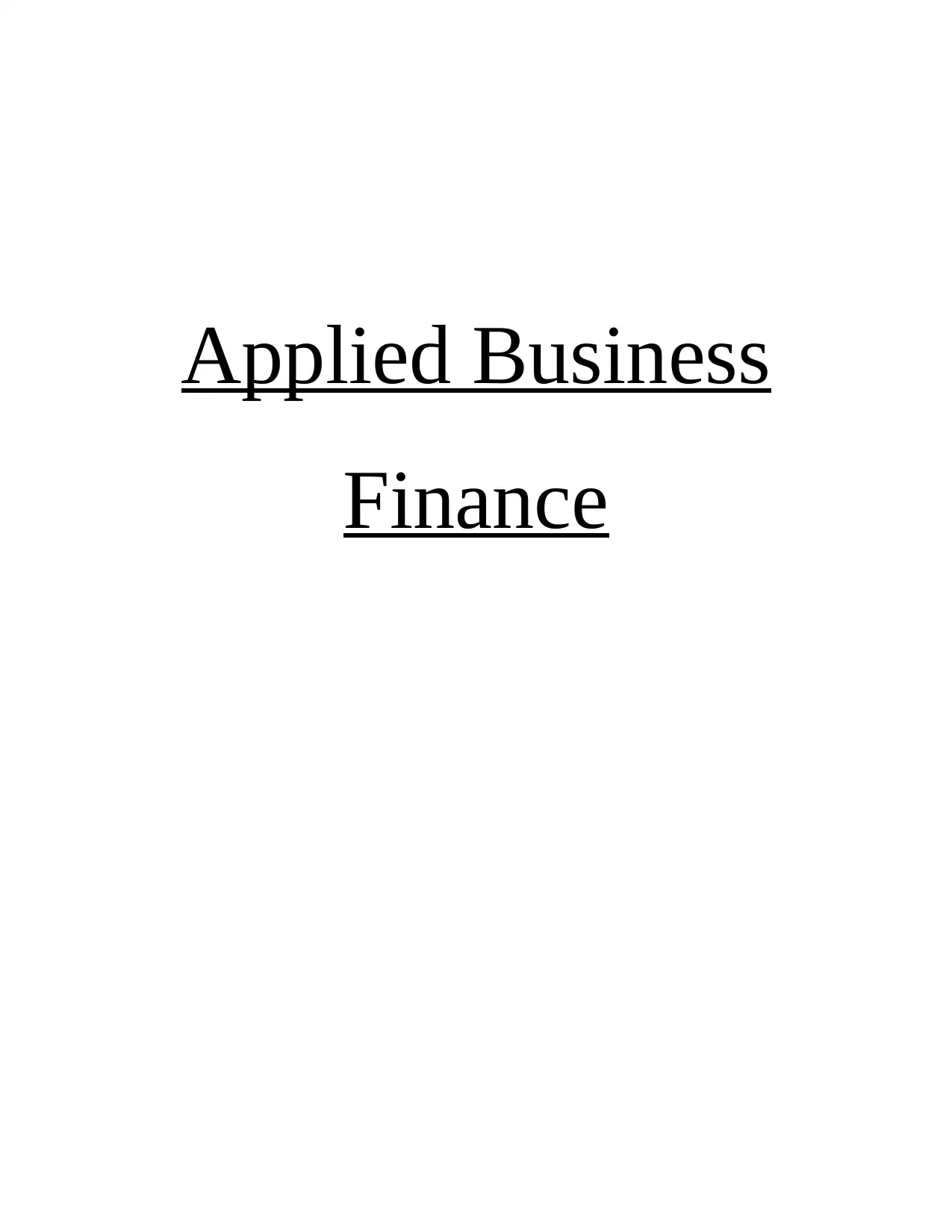
Applied Business
Finance
Finance
Paraphrase This Document
Need a fresh take? Get an instant paraphrase of this document with our AI Paraphraser
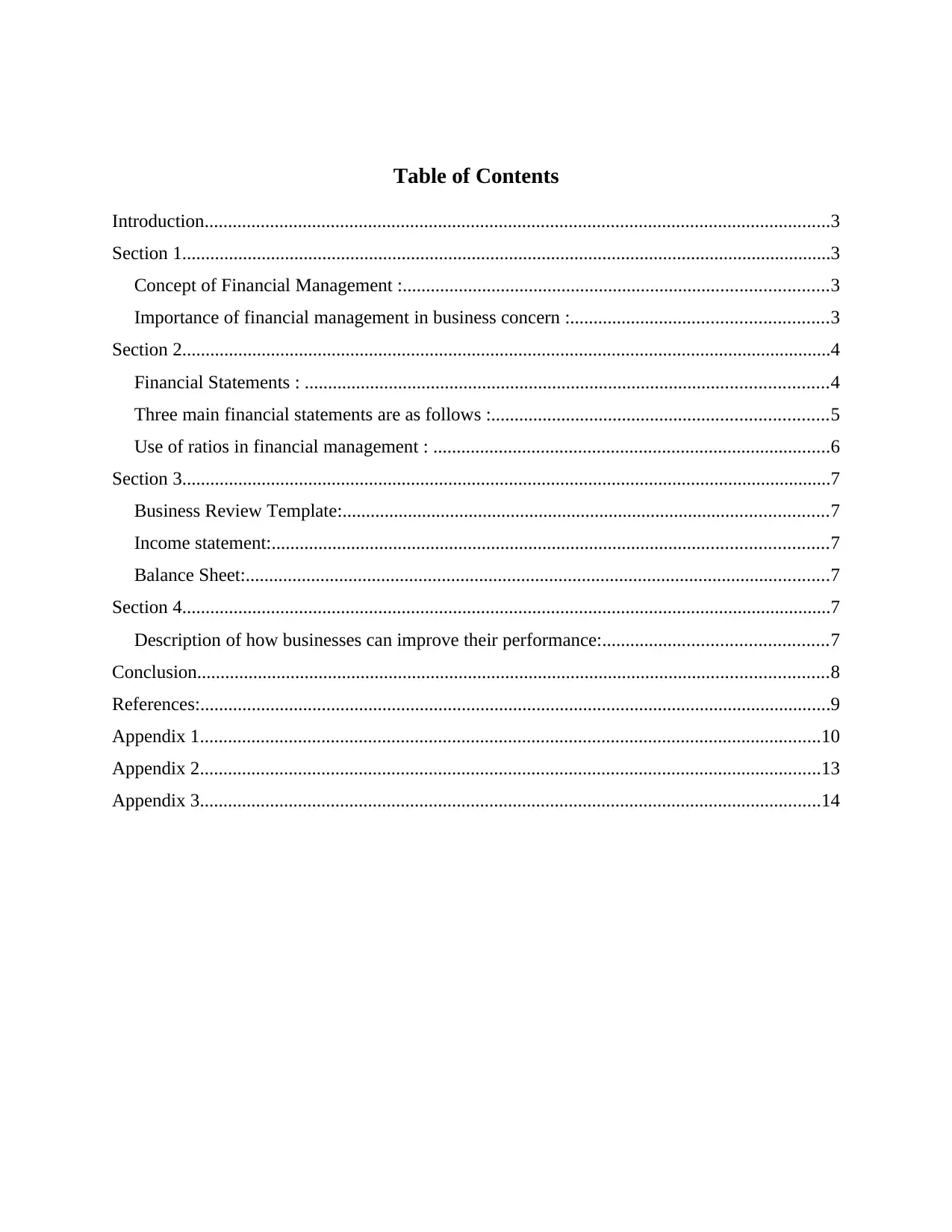
Table of Contents
Introduction......................................................................................................................................3
Section 1...........................................................................................................................................3
Concept of Financial Management :...........................................................................................3
Importance of financial management in business concern :.......................................................3
Section 2...........................................................................................................................................4
Financial Statements : ................................................................................................................4
Three main financial statements are as follows :........................................................................5
Use of ratios in financial management : .....................................................................................6
Section 3...........................................................................................................................................7
Business Review Template:........................................................................................................7
Income statement:.......................................................................................................................7
Balance Sheet:.............................................................................................................................7
Section 4...........................................................................................................................................7
Description of how businesses can improve their performance:................................................7
Conclusion.......................................................................................................................................8
References:.......................................................................................................................................9
Appendix 1.....................................................................................................................................10
Appendix 2.....................................................................................................................................13
Appendix 3.....................................................................................................................................14
Introduction......................................................................................................................................3
Section 1...........................................................................................................................................3
Concept of Financial Management :...........................................................................................3
Importance of financial management in business concern :.......................................................3
Section 2...........................................................................................................................................4
Financial Statements : ................................................................................................................4
Three main financial statements are as follows :........................................................................5
Use of ratios in financial management : .....................................................................................6
Section 3...........................................................................................................................................7
Business Review Template:........................................................................................................7
Income statement:.......................................................................................................................7
Balance Sheet:.............................................................................................................................7
Section 4...........................................................................................................................................7
Description of how businesses can improve their performance:................................................7
Conclusion.......................................................................................................................................8
References:.......................................................................................................................................9
Appendix 1.....................................................................................................................................10
Appendix 2.....................................................................................................................................13
Appendix 3.....................................................................................................................................14
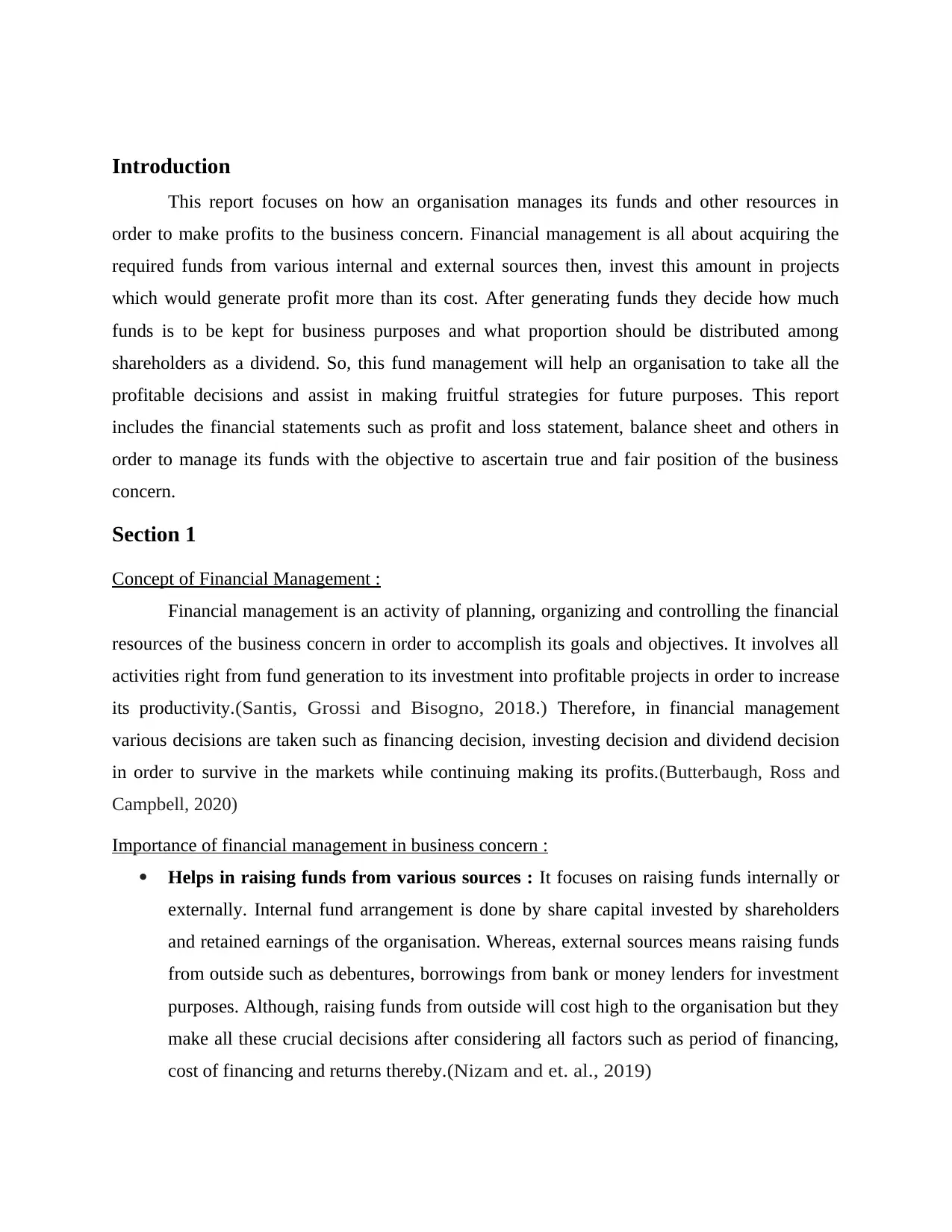
Introduction
This report focuses on how an organisation manages its funds and other resources in
order to make profits to the business concern. Financial management is all about acquiring the
required funds from various internal and external sources then, invest this amount in projects
which would generate profit more than its cost. After generating funds they decide how much
funds is to be kept for business purposes and what proportion should be distributed among
shareholders as a dividend. So, this fund management will help an organisation to take all the
profitable decisions and assist in making fruitful strategies for future purposes. This report
includes the financial statements such as profit and loss statement, balance sheet and others in
order to manage its funds with the objective to ascertain true and fair position of the business
concern.
Section 1
Concept of Financial Management :
Financial management is an activity of planning, organizing and controlling the financial
resources of the business concern in order to accomplish its goals and objectives. It involves all
activities right from fund generation to its investment into profitable projects in order to increase
its productivity. (Santis, Grossi and Bisogno, 2018.) Therefore, in financial management
various decisions are taken such as financing decision, investing decision and dividend decision
in order to survive in the markets while continuing making its profits.(Butterbaugh, Ross and
Campbell, 2020)
Importance of financial management in business concern :
Helps in raising funds from various sources : It focuses on raising funds internally or
externally. Internal fund arrangement is done by share capital invested by shareholders
and retained earnings of the organisation. Whereas, external sources means raising funds
from outside such as debentures, borrowings from bank or money lenders for investment
purposes. Although, raising funds from outside will cost high to the organisation but they
make all these crucial decisions after considering all factors such as period of financing,
cost of financing and returns thereby. (Nizam and et. al., 2019)
This report focuses on how an organisation manages its funds and other resources in
order to make profits to the business concern. Financial management is all about acquiring the
required funds from various internal and external sources then, invest this amount in projects
which would generate profit more than its cost. After generating funds they decide how much
funds is to be kept for business purposes and what proportion should be distributed among
shareholders as a dividend. So, this fund management will help an organisation to take all the
profitable decisions and assist in making fruitful strategies for future purposes. This report
includes the financial statements such as profit and loss statement, balance sheet and others in
order to manage its funds with the objective to ascertain true and fair position of the business
concern.
Section 1
Concept of Financial Management :
Financial management is an activity of planning, organizing and controlling the financial
resources of the business concern in order to accomplish its goals and objectives. It involves all
activities right from fund generation to its investment into profitable projects in order to increase
its productivity. (Santis, Grossi and Bisogno, 2018.) Therefore, in financial management
various decisions are taken such as financing decision, investing decision and dividend decision
in order to survive in the markets while continuing making its profits.(Butterbaugh, Ross and
Campbell, 2020)
Importance of financial management in business concern :
Helps in raising funds from various sources : It focuses on raising funds internally or
externally. Internal fund arrangement is done by share capital invested by shareholders
and retained earnings of the organisation. Whereas, external sources means raising funds
from outside such as debentures, borrowings from bank or money lenders for investment
purposes. Although, raising funds from outside will cost high to the organisation but they
make all these crucial decisions after considering all factors such as period of financing,
cost of financing and returns thereby. (Nizam and et. al., 2019)
⊘ This is a preview!⊘
Do you want full access?
Subscribe today to unlock all pages.

Trusted by 1+ million students worldwide
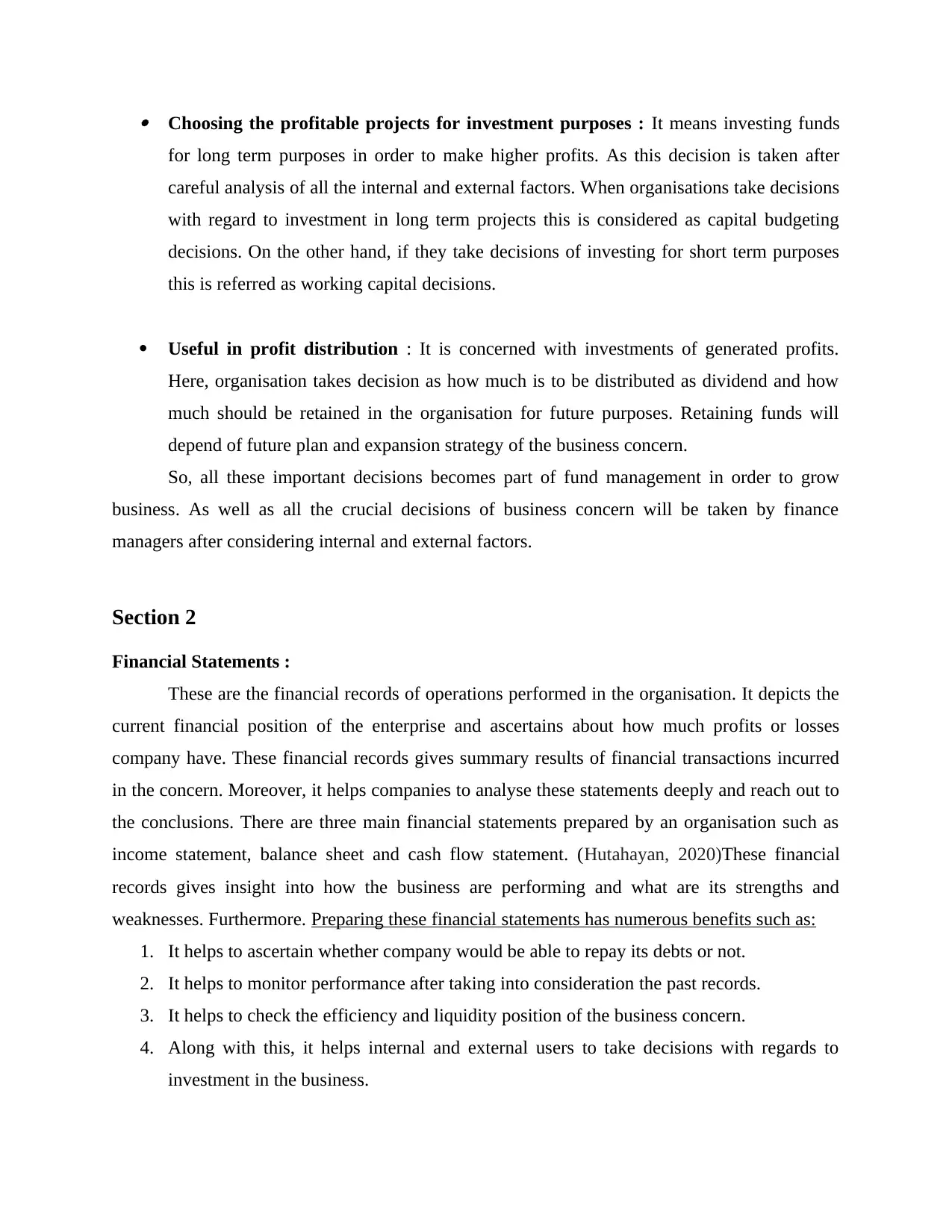
Choosing the profitable projects for investment purposes : It means investing funds
for long term purposes in order to make higher profits. As this decision is taken after
careful analysis of all the internal and external factors. When organisations take decisions
with regard to investment in long term projects this is considered as capital budgeting
decisions. On the other hand, if they take decisions of investing for short term purposes
this is referred as working capital decisions.
Useful in profit distribution : It is concerned with investments of generated profits.
Here, organisation takes decision as how much is to be distributed as dividend and how
much should be retained in the organisation for future purposes. Retaining funds will
depend of future plan and expansion strategy of the business concern.
So, all these important decisions becomes part of fund management in order to grow
business. As well as all the crucial decisions of business concern will be taken by finance
managers after considering internal and external factors.
Section 2
Financial Statements :
These are the financial records of operations performed in the organisation. It depicts the
current financial position of the enterprise and ascertains about how much profits or losses
company have. These financial records gives summary results of financial transactions incurred
in the concern. Moreover, it helps companies to analyse these statements deeply and reach out to
the conclusions. There are three main financial statements prepared by an organisation such as
income statement, balance sheet and cash flow statement. (Hutahayan, 2020)These financial
records gives insight into how the business are performing and what are its strengths and
weaknesses. Furthermore. Preparing these financial statements has numerous benefits such as:
1. It helps to ascertain whether company would be able to repay its debts or not.
2. It helps to monitor performance after taking into consideration the past records.
3. It helps to check the efficiency and liquidity position of the business concern.
4. Along with this, it helps internal and external users to take decisions with regards to
investment in the business.
for long term purposes in order to make higher profits. As this decision is taken after
careful analysis of all the internal and external factors. When organisations take decisions
with regard to investment in long term projects this is considered as capital budgeting
decisions. On the other hand, if they take decisions of investing for short term purposes
this is referred as working capital decisions.
Useful in profit distribution : It is concerned with investments of generated profits.
Here, organisation takes decision as how much is to be distributed as dividend and how
much should be retained in the organisation for future purposes. Retaining funds will
depend of future plan and expansion strategy of the business concern.
So, all these important decisions becomes part of fund management in order to grow
business. As well as all the crucial decisions of business concern will be taken by finance
managers after considering internal and external factors.
Section 2
Financial Statements :
These are the financial records of operations performed in the organisation. It depicts the
current financial position of the enterprise and ascertains about how much profits or losses
company have. These financial records gives summary results of financial transactions incurred
in the concern. Moreover, it helps companies to analyse these statements deeply and reach out to
the conclusions. There are three main financial statements prepared by an organisation such as
income statement, balance sheet and cash flow statement. (Hutahayan, 2020)These financial
records gives insight into how the business are performing and what are its strengths and
weaknesses. Furthermore. Preparing these financial statements has numerous benefits such as:
1. It helps to ascertain whether company would be able to repay its debts or not.
2. It helps to monitor performance after taking into consideration the past records.
3. It helps to check the efficiency and liquidity position of the business concern.
4. Along with this, it helps internal and external users to take decisions with regards to
investment in the business.
Paraphrase This Document
Need a fresh take? Get an instant paraphrase of this document with our AI Paraphraser
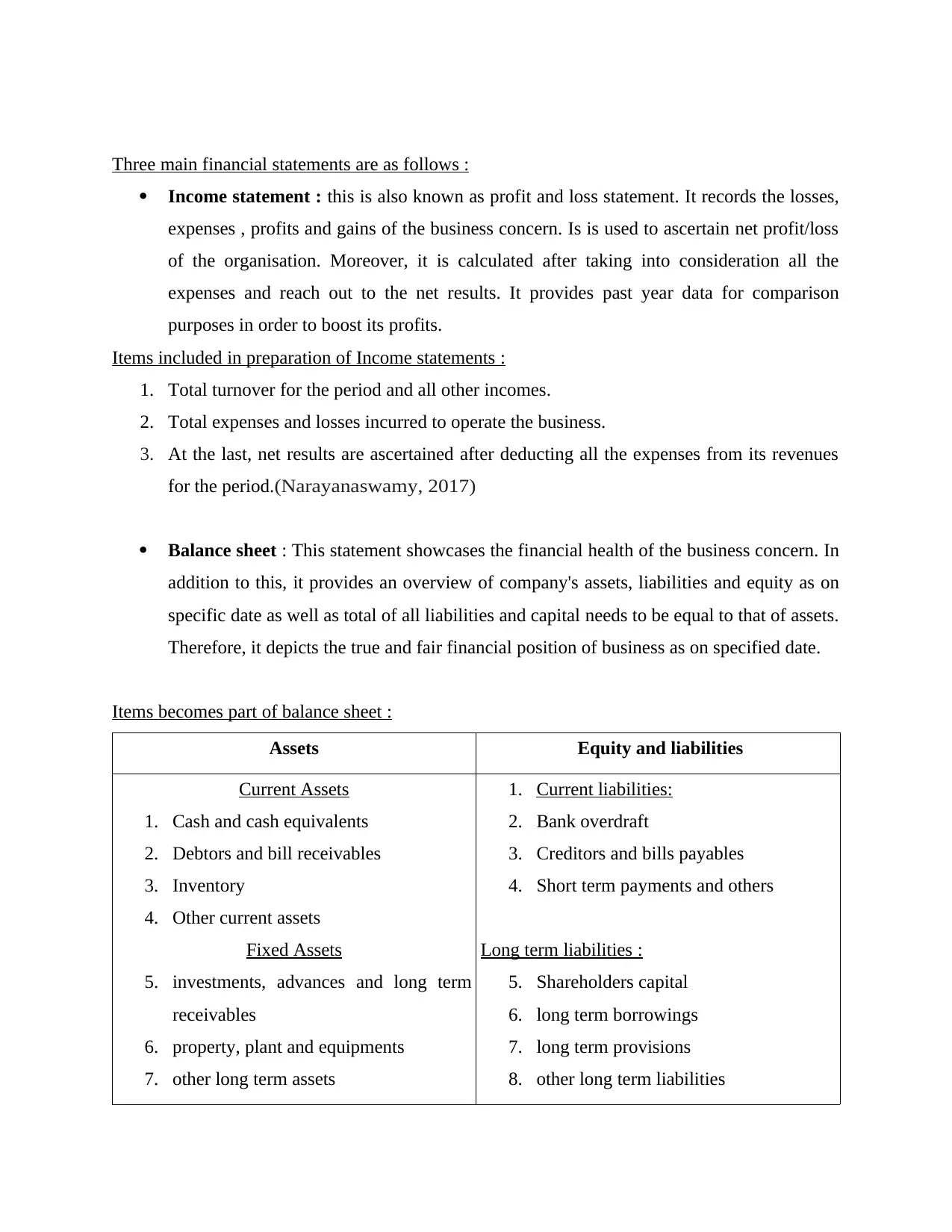
Three main financial statements are as follows :
Income statement : this is also known as profit and loss statement. It records the losses,
expenses , profits and gains of the business concern. Is is used to ascertain net profit/loss
of the organisation. Moreover, it is calculated after taking into consideration all the
expenses and reach out to the net results. It provides past year data for comparison
purposes in order to boost its profits.
Items included in preparation of Income statements :
1. Total turnover for the period and all other incomes.
2. Total expenses and losses incurred to operate the business.
3. At the last, net results are ascertained after deducting all the expenses from its revenues
for the period. (Narayanaswamy, 2017)
Balance sheet : This statement showcases the financial health of the business concern. In
addition to this, it provides an overview of company's assets, liabilities and equity as on
specific date as well as total of all liabilities and capital needs to be equal to that of assets.
Therefore, it depicts the true and fair financial position of business as on specified date.
Items becomes part of balance sheet :
Assets Equity and liabilities
Current Assets
1. Cash and cash equivalents
2. Debtors and bill receivables
3. Inventory
4. Other current assets
Fixed Assets
5. investments, advances and long term
receivables
6. property, plant and equipments
7. other long term assets
1. Current liabilities:
2. Bank overdraft
3. Creditors and bills payables
4. Short term payments and others
Long term liabilities :
5. Shareholders capital
6. long term borrowings
7. long term provisions
8. other long term liabilities
Income statement : this is also known as profit and loss statement. It records the losses,
expenses , profits and gains of the business concern. Is is used to ascertain net profit/loss
of the organisation. Moreover, it is calculated after taking into consideration all the
expenses and reach out to the net results. It provides past year data for comparison
purposes in order to boost its profits.
Items included in preparation of Income statements :
1. Total turnover for the period and all other incomes.
2. Total expenses and losses incurred to operate the business.
3. At the last, net results are ascertained after deducting all the expenses from its revenues
for the period. (Narayanaswamy, 2017)
Balance sheet : This statement showcases the financial health of the business concern. In
addition to this, it provides an overview of company's assets, liabilities and equity as on
specific date as well as total of all liabilities and capital needs to be equal to that of assets.
Therefore, it depicts the true and fair financial position of business as on specified date.
Items becomes part of balance sheet :
Assets Equity and liabilities
Current Assets
1. Cash and cash equivalents
2. Debtors and bill receivables
3. Inventory
4. Other current assets
Fixed Assets
5. investments, advances and long term
receivables
6. property, plant and equipments
7. other long term assets
1. Current liabilities:
2. Bank overdraft
3. Creditors and bills payables
4. Short term payments and others
Long term liabilities :
5. Shareholders capital
6. long term borrowings
7. long term provisions
8. other long term liabilities
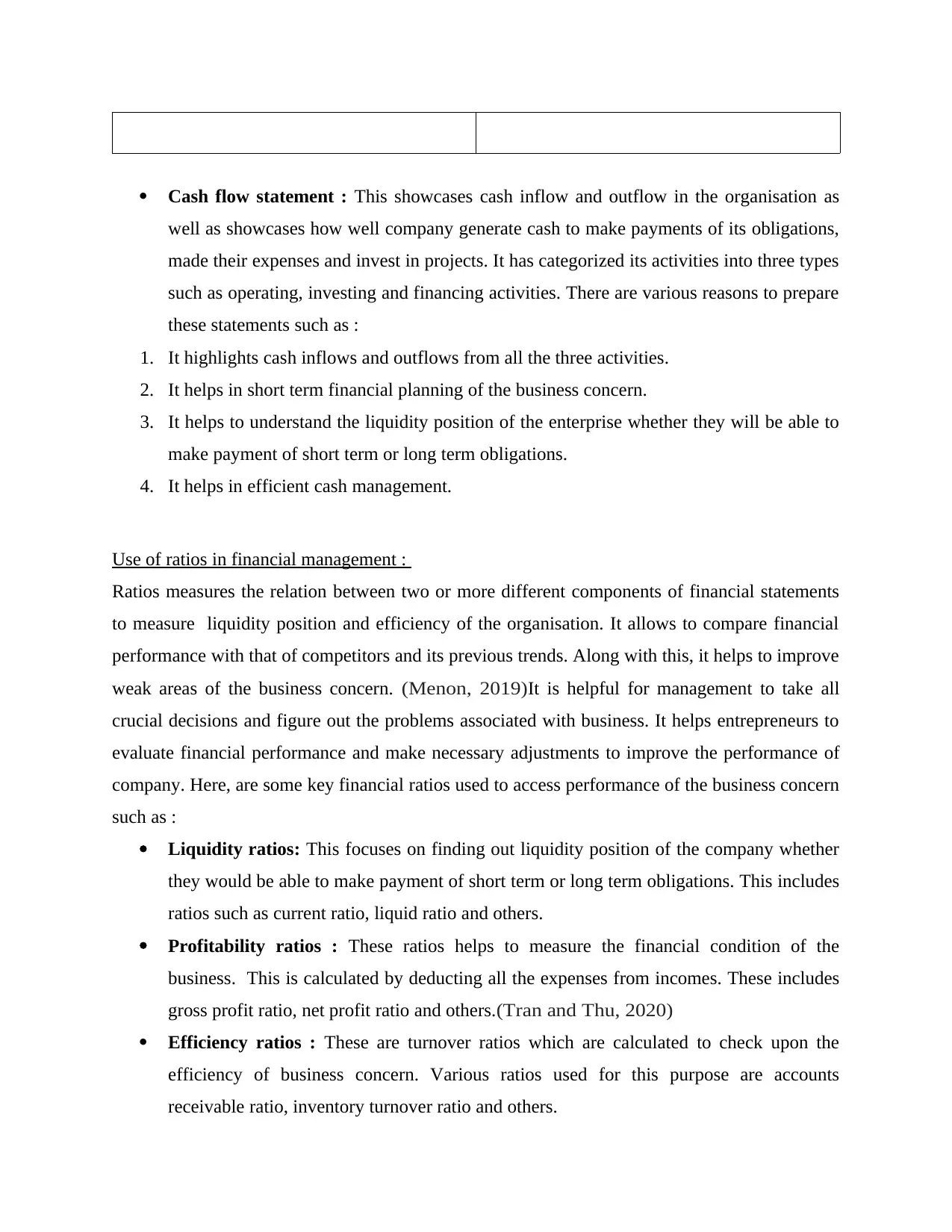
Cash flow statement : This showcases cash inflow and outflow in the organisation as
well as showcases how well company generate cash to make payments of its obligations,
made their expenses and invest in projects. It has categorized its activities into three types
such as operating, investing and financing activities. There are various reasons to prepare
these statements such as :
1. It highlights cash inflows and outflows from all the three activities.
2. It helps in short term financial planning of the business concern.
3. It helps to understand the liquidity position of the enterprise whether they will be able to
make payment of short term or long term obligations.
4. It helps in efficient cash management.
Use of ratios in financial management :
Ratios measures the relation between two or more different components of financial statements
to measure liquidity position and efficiency of the organisation. It allows to compare financial
performance with that of competitors and its previous trends. Along with this, it helps to improve
weak areas of the business concern. (Menon, 2019)It is helpful for management to take all
crucial decisions and figure out the problems associated with business. It helps entrepreneurs to
evaluate financial performance and make necessary adjustments to improve the performance of
company. Here, are some key financial ratios used to access performance of the business concern
such as :
Liquidity ratios: This focuses on finding out liquidity position of the company whether
they would be able to make payment of short term or long term obligations. This includes
ratios such as current ratio, liquid ratio and others.
Profitability ratios : These ratios helps to measure the financial condition of the
business. This is calculated by deducting all the expenses from incomes. These includes
gross profit ratio, net profit ratio and others. (Tran and Thu, 2020)
Efficiency ratios : These are turnover ratios which are calculated to check upon the
efficiency of business concern. Various ratios used for this purpose are accounts
receivable ratio, inventory turnover ratio and others.
well as showcases how well company generate cash to make payments of its obligations,
made their expenses and invest in projects. It has categorized its activities into three types
such as operating, investing and financing activities. There are various reasons to prepare
these statements such as :
1. It highlights cash inflows and outflows from all the three activities.
2. It helps in short term financial planning of the business concern.
3. It helps to understand the liquidity position of the enterprise whether they will be able to
make payment of short term or long term obligations.
4. It helps in efficient cash management.
Use of ratios in financial management :
Ratios measures the relation between two or more different components of financial statements
to measure liquidity position and efficiency of the organisation. It allows to compare financial
performance with that of competitors and its previous trends. Along with this, it helps to improve
weak areas of the business concern. (Menon, 2019)It is helpful for management to take all
crucial decisions and figure out the problems associated with business. It helps entrepreneurs to
evaluate financial performance and make necessary adjustments to improve the performance of
company. Here, are some key financial ratios used to access performance of the business concern
such as :
Liquidity ratios: This focuses on finding out liquidity position of the company whether
they would be able to make payment of short term or long term obligations. This includes
ratios such as current ratio, liquid ratio and others.
Profitability ratios : These ratios helps to measure the financial condition of the
business. This is calculated by deducting all the expenses from incomes. These includes
gross profit ratio, net profit ratio and others. (Tran and Thu, 2020)
Efficiency ratios : These are turnover ratios which are calculated to check upon the
efficiency of business concern. Various ratios used for this purpose are accounts
receivable ratio, inventory turnover ratio and others.
⊘ This is a preview!⊘
Do you want full access?
Subscribe today to unlock all pages.

Trusted by 1+ million students worldwide
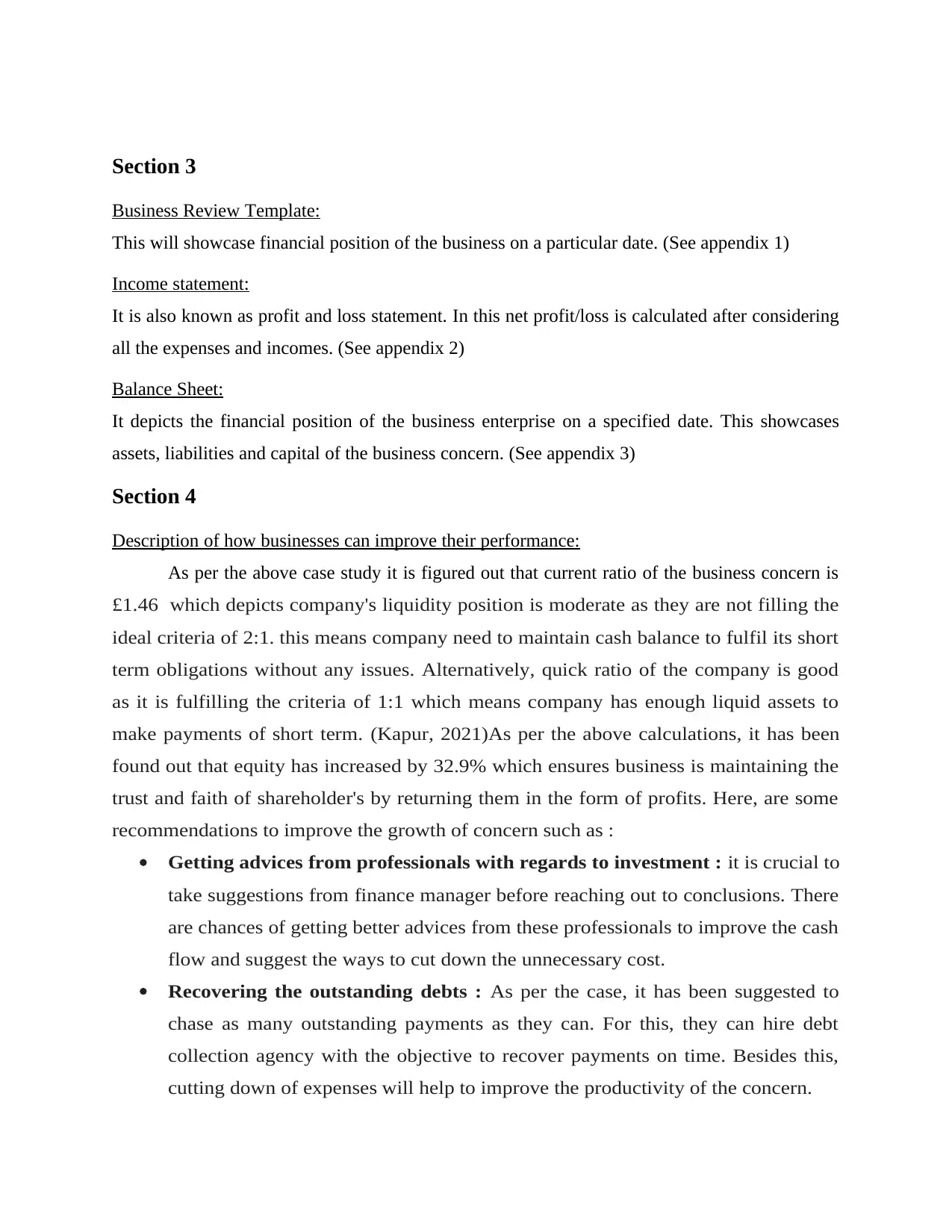
Section 3
Business Review Template:
This will showcase financial position of the business on a particular date. (See appendix 1)
Income statement:
It is also known as profit and loss statement. In this net profit/loss is calculated after considering
all the expenses and incomes. (See appendix 2)
Balance Sheet:
It depicts the financial position of the business enterprise on a specified date. This showcases
assets, liabilities and capital of the business concern. (See appendix 3)
Section 4
Description of how businesses can improve their performance:
As per the above case study it is figured out that current ratio of the business concern is
£1.46 which depicts company's liquidity position is moderate as they are not filling the
ideal criteria of 2:1. this means company need to maintain cash balance to fulfil its short
term obligations without any issues. Alternatively, quick ratio of the company is good
as it is fulfilling the criteria of 1:1 which means company has enough liquid assets to
make payments of short term. (Kapur, 2021)As per the above calculations, it has been
found out that equity has increased by 32.9% which ensures business is maintaining the
trust and faith of shareholder's by returning them in the form of profits. Here, are some
recommendations to improve the growth of concern such as :
Getting advices from professionals with regards to investment : it is crucial to
take suggestions from finance manager before reaching out to conclusions. There
are chances of getting better advices from these professionals to improve the cash
flow and suggest the ways to cut down the unnecessary cost.
Recovering the outstanding debts : As per the case, it has been suggested to
chase as many outstanding payments as they can. For this, they can hire debt
collection agency with the objective to recover payments on time. Besides this,
cutting down of expenses will help to improve the productivity of the concern.
Business Review Template:
This will showcase financial position of the business on a particular date. (See appendix 1)
Income statement:
It is also known as profit and loss statement. In this net profit/loss is calculated after considering
all the expenses and incomes. (See appendix 2)
Balance Sheet:
It depicts the financial position of the business enterprise on a specified date. This showcases
assets, liabilities and capital of the business concern. (See appendix 3)
Section 4
Description of how businesses can improve their performance:
As per the above case study it is figured out that current ratio of the business concern is
£1.46 which depicts company's liquidity position is moderate as they are not filling the
ideal criteria of 2:1. this means company need to maintain cash balance to fulfil its short
term obligations without any issues. Alternatively, quick ratio of the company is good
as it is fulfilling the criteria of 1:1 which means company has enough liquid assets to
make payments of short term. (Kapur, 2021)As per the above calculations, it has been
found out that equity has increased by 32.9% which ensures business is maintaining the
trust and faith of shareholder's by returning them in the form of profits. Here, are some
recommendations to improve the growth of concern such as :
Getting advices from professionals with regards to investment : it is crucial to
take suggestions from finance manager before reaching out to conclusions. There
are chances of getting better advices from these professionals to improve the cash
flow and suggest the ways to cut down the unnecessary cost.
Recovering the outstanding debts : As per the case, it has been suggested to
chase as many outstanding payments as they can. For this, they can hire debt
collection agency with the objective to recover payments on time. Besides this,
cutting down of expenses will help to improve the productivity of the concern.
Paraphrase This Document
Need a fresh take? Get an instant paraphrase of this document with our AI Paraphraser
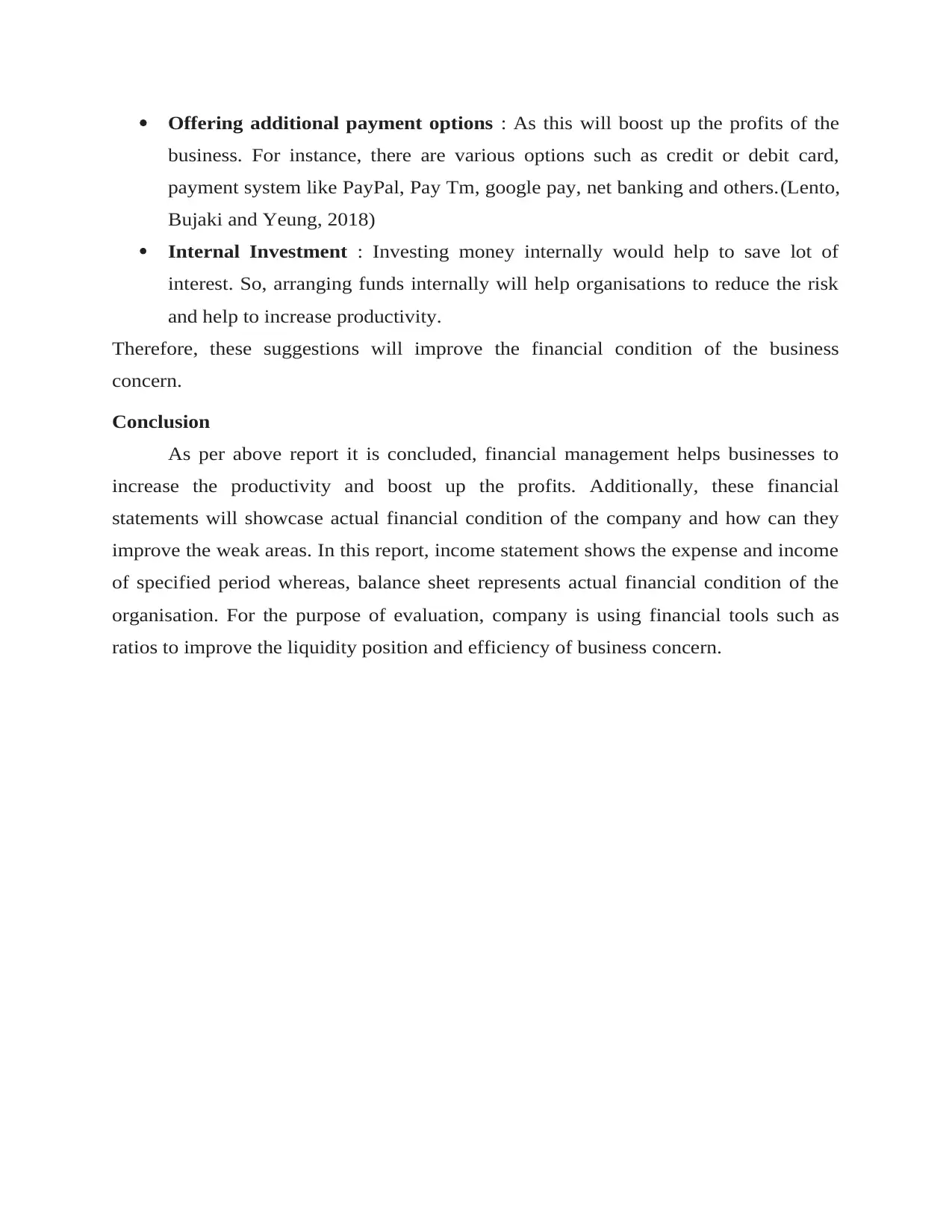
Offering additional payment options : As this will boost up the profits of the
business. For instance, there are various options such as credit or debit card,
payment system like PayPal, Pay Tm, google pay, net banking and others.(Lento,
Bujaki and Yeung, 2018)
Internal Investment : Investing money internally would help to save lot of
interest. So, arranging funds internally will help organisations to reduce the risk
and help to increase productivity.
Therefore, these suggestions will improve the financial condition of the business
concern.
Conclusion
As per above report it is concluded, financial management helps businesses to
increase the productivity and boost up the profits. Additionally, these financial
statements will showcase actual financial condition of the company and how can they
improve the weak areas. In this report, income statement shows the expense and income
of specified period whereas, balance sheet represents actual financial condition of the
organisation. For the purpose of evaluation, company is using financial tools such as
ratios to improve the liquidity position and efficiency of business concern.
business. For instance, there are various options such as credit or debit card,
payment system like PayPal, Pay Tm, google pay, net banking and others.(Lento,
Bujaki and Yeung, 2018)
Internal Investment : Investing money internally would help to save lot of
interest. So, arranging funds internally will help organisations to reduce the risk
and help to increase productivity.
Therefore, these suggestions will improve the financial condition of the business
concern.
Conclusion
As per above report it is concluded, financial management helps businesses to
increase the productivity and boost up the profits. Additionally, these financial
statements will showcase actual financial condition of the company and how can they
improve the weak areas. In this report, income statement shows the expense and income
of specified period whereas, balance sheet represents actual financial condition of the
organisation. For the purpose of evaluation, company is using financial tools such as
ratios to improve the liquidity position and efficiency of business concern.
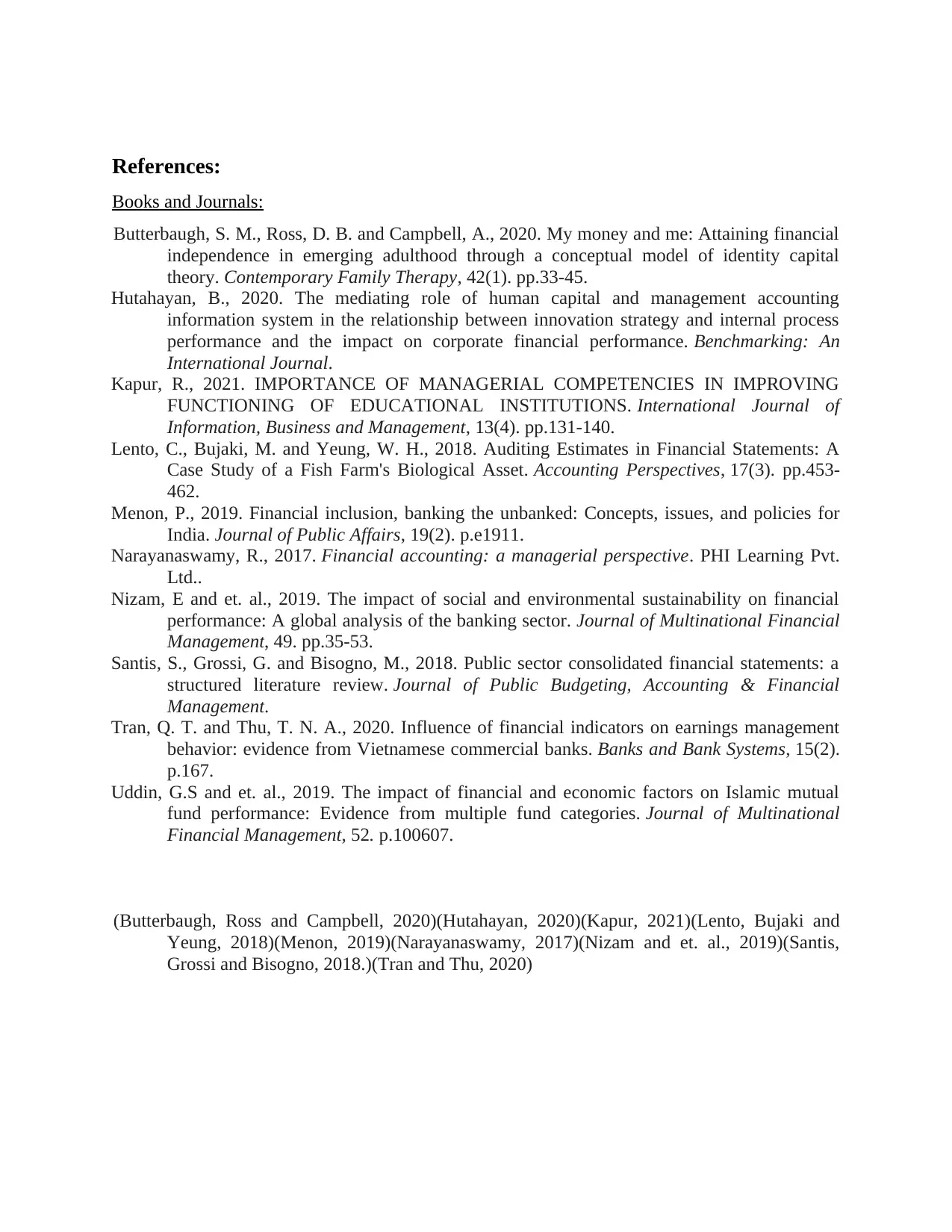
References:
Books and Journals:
Butterbaugh, S. M., Ross, D. B. and Campbell, A., 2020. My money and me: Attaining financial
independence in emerging adulthood through a conceptual model of identity capital
theory. Contemporary Family Therapy, 42(1). pp.33-45.
Hutahayan, B., 2020. The mediating role of human capital and management accounting
information system in the relationship between innovation strategy and internal process
performance and the impact on corporate financial performance. Benchmarking: An
International Journal.
Kapur, R., 2021. IMPORTANCE OF MANAGERIAL COMPETENCIES IN IMPROVING
FUNCTIONING OF EDUCATIONAL INSTITUTIONS. International Journal of
Information, Business and Management, 13(4). pp.131-140.
Lento, C., Bujaki, M. and Yeung, W. H., 2018. Auditing Estimates in Financial Statements: A
Case Study of a Fish Farm's Biological Asset. Accounting Perspectives, 17(3). pp.453-
462.
Menon, P., 2019. Financial inclusion, banking the unbanked: Concepts, issues, and policies for
India. Journal of Public Affairs, 19(2). p.e1911.
Narayanaswamy, R., 2017. Financial accounting: a managerial perspective. PHI Learning Pvt.
Ltd..
Nizam, E and et. al., 2019. The impact of social and environmental sustainability on financial
performance: A global analysis of the banking sector. Journal of Multinational Financial
Management, 49. pp.35-53.
Santis, S., Grossi, G. and Bisogno, M., 2018. Public sector consolidated financial statements: a
structured literature review. Journal of Public Budgeting, Accounting & Financial
Management.
Tran, Q. T. and Thu, T. N. A., 2020. Influence of financial indicators on earnings management
behavior: evidence from Vietnamese commercial banks. Banks and Bank Systems, 15(2).
p.167.
Uddin, G.S and et. al., 2019. The impact of financial and economic factors on Islamic mutual
fund performance: Evidence from multiple fund categories. Journal of Multinational
Financial Management, 52. p.100607.
(Butterbaugh, Ross and Campbell, 2020)(Hutahayan, 2020)(Kapur, 2021)(Lento, Bujaki and
Yeung, 2018)(Menon, 2019)(Narayanaswamy, 2017)(Nizam and et. al., 2019)(Santis,
Grossi and Bisogno, 2018.)(Tran and Thu, 2020)
Books and Journals:
Butterbaugh, S. M., Ross, D. B. and Campbell, A., 2020. My money and me: Attaining financial
independence in emerging adulthood through a conceptual model of identity capital
theory. Contemporary Family Therapy, 42(1). pp.33-45.
Hutahayan, B., 2020. The mediating role of human capital and management accounting
information system in the relationship between innovation strategy and internal process
performance and the impact on corporate financial performance. Benchmarking: An
International Journal.
Kapur, R., 2021. IMPORTANCE OF MANAGERIAL COMPETENCIES IN IMPROVING
FUNCTIONING OF EDUCATIONAL INSTITUTIONS. International Journal of
Information, Business and Management, 13(4). pp.131-140.
Lento, C., Bujaki, M. and Yeung, W. H., 2018. Auditing Estimates in Financial Statements: A
Case Study of a Fish Farm's Biological Asset. Accounting Perspectives, 17(3). pp.453-
462.
Menon, P., 2019. Financial inclusion, banking the unbanked: Concepts, issues, and policies for
India. Journal of Public Affairs, 19(2). p.e1911.
Narayanaswamy, R., 2017. Financial accounting: a managerial perspective. PHI Learning Pvt.
Ltd..
Nizam, E and et. al., 2019. The impact of social and environmental sustainability on financial
performance: A global analysis of the banking sector. Journal of Multinational Financial
Management, 49. pp.35-53.
Santis, S., Grossi, G. and Bisogno, M., 2018. Public sector consolidated financial statements: a
structured literature review. Journal of Public Budgeting, Accounting & Financial
Management.
Tran, Q. T. and Thu, T. N. A., 2020. Influence of financial indicators on earnings management
behavior: evidence from Vietnamese commercial banks. Banks and Bank Systems, 15(2).
p.167.
Uddin, G.S and et. al., 2019. The impact of financial and economic factors on Islamic mutual
fund performance: Evidence from multiple fund categories. Journal of Multinational
Financial Management, 52. p.100607.
(Butterbaugh, Ross and Campbell, 2020)(Hutahayan, 2020)(Kapur, 2021)(Lento, Bujaki and
Yeung, 2018)(Menon, 2019)(Narayanaswamy, 2017)(Nizam and et. al., 2019)(Santis,
Grossi and Bisogno, 2018.)(Tran and Thu, 2020)
⊘ This is a preview!⊘
Do you want full access?
Subscribe today to unlock all pages.

Trusted by 1+ million students worldwide
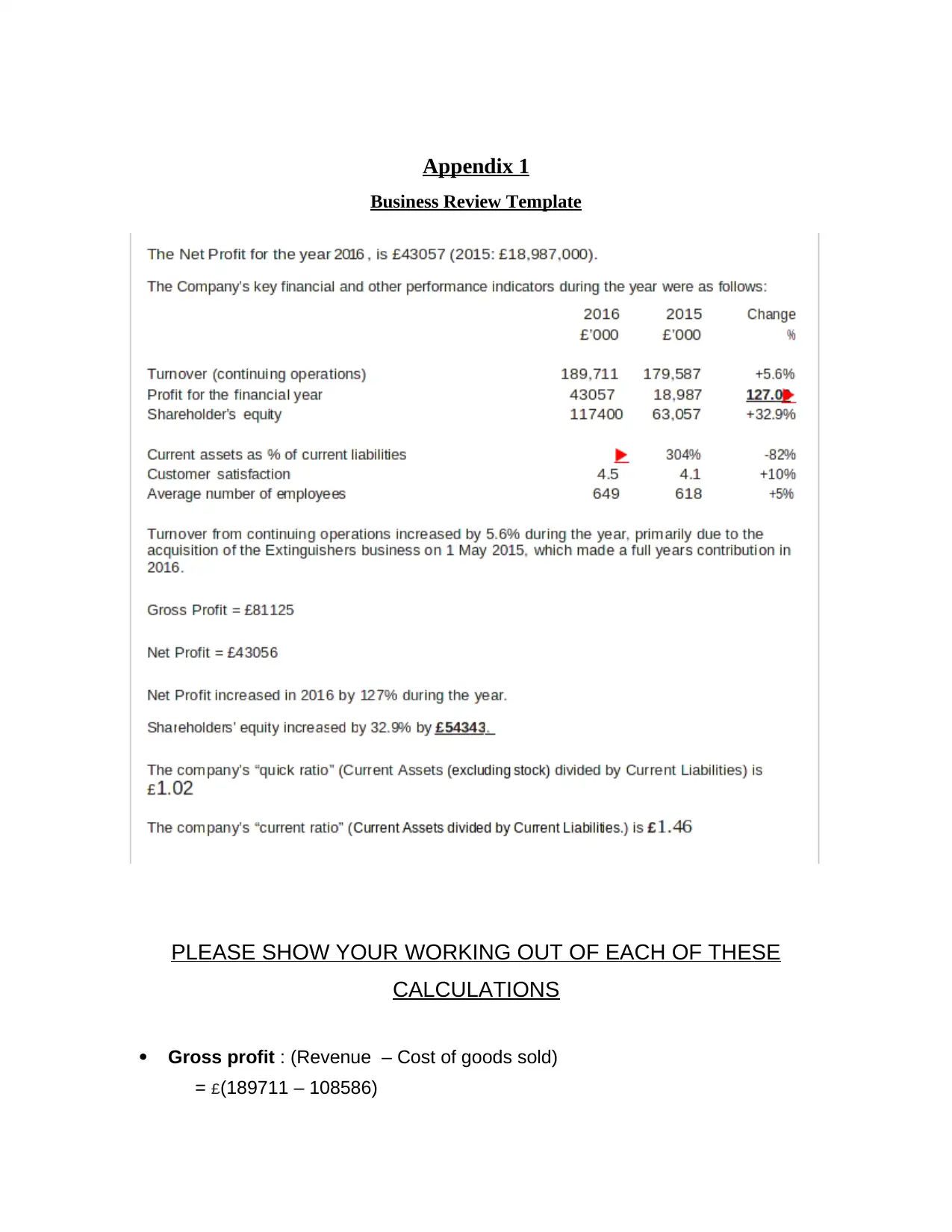
Appendix 1
Business Review Template
PLEASE SHOW YOUR WORKING OUT OF EACH OF THESE
CALCULATIONS
Gross profit : (Revenue – Cost of goods sold)
= £(189711 – 108586)
Business Review Template
PLEASE SHOW YOUR WORKING OUT OF EACH OF THESE
CALCULATIONS
Gross profit : (Revenue – Cost of goods sold)
= £(189711 – 108586)
Paraphrase This Document
Need a fresh take? Get an instant paraphrase of this document with our AI Paraphraser
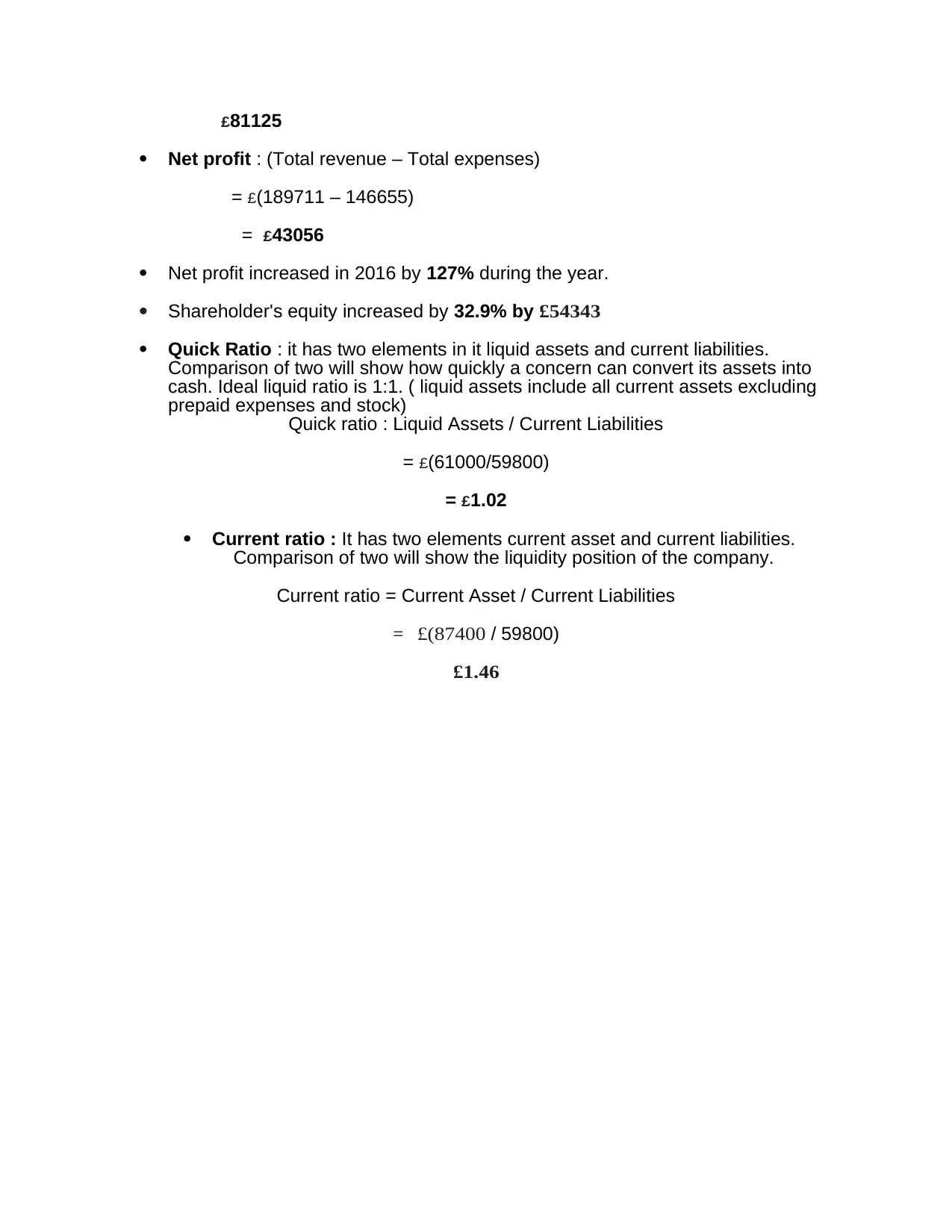
£81125
Net profit : (Total revenue – Total expenses)
= £(189711 – 146655)
= £43056
Net profit increased in 2016 by 127% during the year.
Shareholder's equity increased by 32.9% by £54343
Quick Ratio : it has two elements in it liquid assets and current liabilities.
Comparison of two will show how quickly a concern can convert its assets into
cash. Ideal liquid ratio is 1:1. ( liquid assets include all current assets excluding
prepaid expenses and stock)
Quick ratio : Liquid Assets / Current Liabilities
= £(61000/59800)
= £1.02
Current ratio : It has two elements current asset and current liabilities.
Comparison of two will show the liquidity position of the company.
Current ratio = Current Asset / Current Liabilities
= £(87400 / 59800)
£1.46
Net profit : (Total revenue – Total expenses)
= £(189711 – 146655)
= £43056
Net profit increased in 2016 by 127% during the year.
Shareholder's equity increased by 32.9% by £54343
Quick Ratio : it has two elements in it liquid assets and current liabilities.
Comparison of two will show how quickly a concern can convert its assets into
cash. Ideal liquid ratio is 1:1. ( liquid assets include all current assets excluding
prepaid expenses and stock)
Quick ratio : Liquid Assets / Current Liabilities
= £(61000/59800)
= £1.02
Current ratio : It has two elements current asset and current liabilities.
Comparison of two will show the liquidity position of the company.
Current ratio = Current Asset / Current Liabilities
= £(87400 / 59800)
£1.46
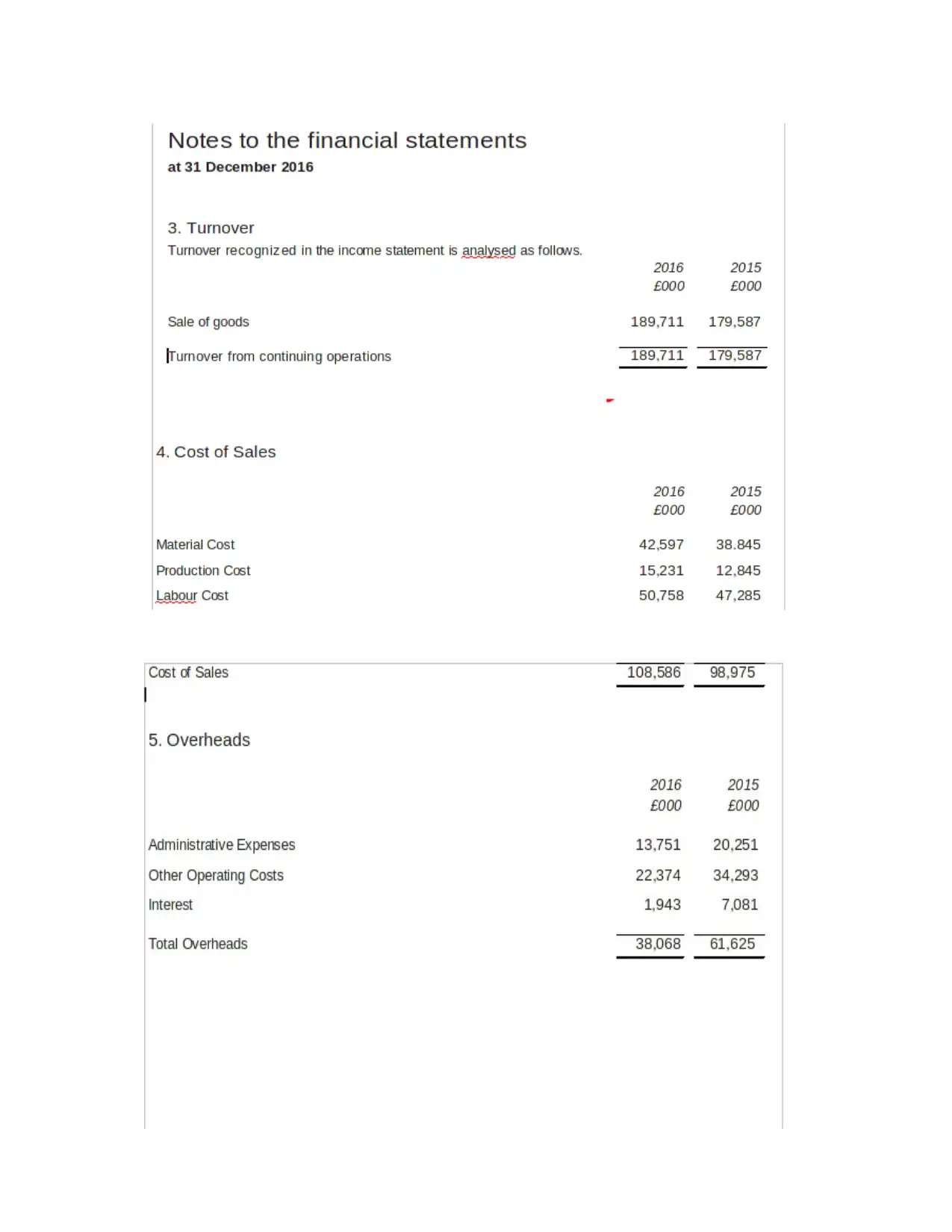
⊘ This is a preview!⊘
Do you want full access?
Subscribe today to unlock all pages.

Trusted by 1+ million students worldwide
1 out of 16
Related Documents
Your All-in-One AI-Powered Toolkit for Academic Success.
+13062052269
info@desklib.com
Available 24*7 on WhatsApp / Email
![[object Object]](/_next/static/media/star-bottom.7253800d.svg)
Unlock your academic potential
Copyright © 2020–2025 A2Z Services. All Rights Reserved. Developed and managed by ZUCOL.

